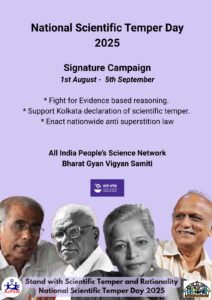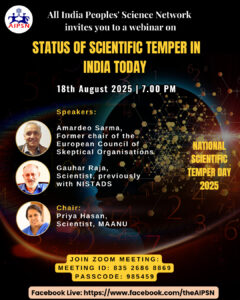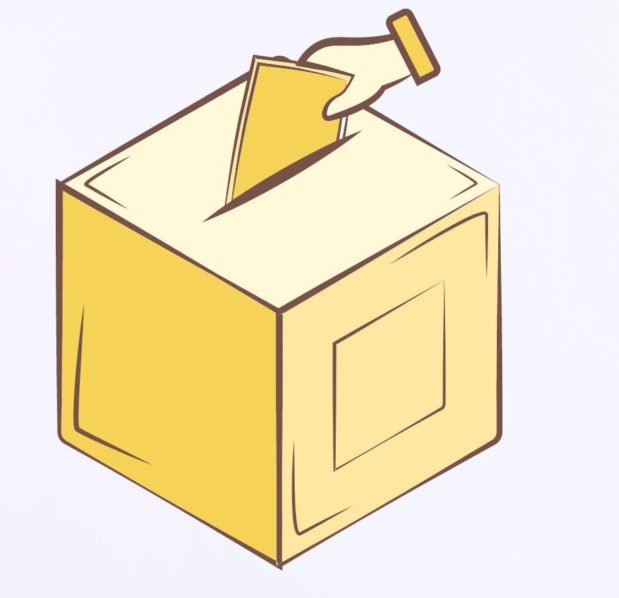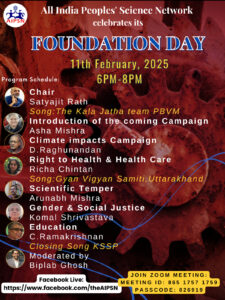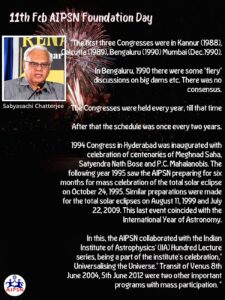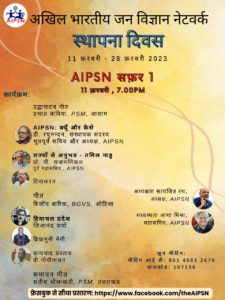Click here to see press coverage in Science
All India Peoples Science Network (AIPSN) Statement
30 Oct 2023
AIPSN Demands recall of NCERT special modules on Chandrayaan 3:
Modules filled with errors and pseudoscientific claims
ON 17 October 2023, NCERT released a number of special modules in English and Hindi on Chandrayaan 3, for circulating to millions of school students as supplementary reading material. However due to severe criticism as seen in press and media coverage the NCERT initially took down the webpage on the modules but after the Government defended the modules in a PIB release on 25 October saying “Mythology and philosophy put forward ideas and ideas lead to innovation and research” the website came back online! These modules were targeted towards different learning stages as described in NEP 2020 (Foundational, Primary, Middle School, Secondary and Higher Secondary). Shockingly, many scientific and technical errors occur in the content of these modules, some of which are pointed out below. In addition, there are pseudo-scientific claims and misleading scientific content, and even a reference to a Nazi scientist, quite out of sync with the usual standards of material from NCERT, apart from numerous grammatical errors in the English versions.
There is a clear danger that this wrong information will be transmitted to students as-is and cause real harm. Or worse: the content is so badly written that students will be put off this exciting field.
Members of the scientific community and all rationally minded citizens should summarily reject this shoddily prepared material. The way NCERT reacted after the criticism to withdraw them and then put them back on after the government defended the mythology must not happen again. The demand is that NCERT recalls all these modules at once permanently.
List of Scientific Errors, Pseudoscientific claims and Falsehoods in the NCERT modules on Chandrayaan
Foundational Stage (code 1.1F, kindergarten and grades 1-2):
-
- Text: (for Chandrayaan 2) … this time due to a malfunction in the parts of the rocket, it lost contact with the Earth …
Reality: The launcher rocket worked perfectly, and although the lander failed, the orbiter module of Chandrayaan kept working and ISRO kept receiving data.
- Primary Stage (code 1.2P, grades 3-5):
- Text: this rocket has two major parts—one is Rover and the other is Lander which send us information about the Moon.
Reality: The rocket (LVM3) carried the Chandrayaan 3 spacecraft. The spacecraft itself had an orbiter and a lander. The rover was kept inside the lander to get released after landing on the Moon.
- Middle School Stage (code: 1.3M, grades 6-8):
- Text: Literature tells us that it can be traced back through Vymaanika Shastra: ‘Science of Aeronautics’, which reveals that our country had the knowledge of flying vehicles in those days (This book has mind boggling details of construction, working of engines and the gyroscopic systems).
Reality: It has been conclusively shown through research that the origin of the much touted Vymaanika Shastra text can only be traced to the early 20th century and the designs, engines and instruments described in it are completely imaginary, unscientific and useless.
- Text: The Vedas, … makes a mention of … these chariots could also fly. The Rig Veda (verses 1.16.47-48) specifically mentions “mechanical birds.” There are various mentions of flying chariots (Rath) and flying vehicles (Vimaan) which were used in battles and wars. All gods … travel from one place to another. These places included earth, heaven, planets and cosmic destinations called ‘Loks’. Such vehicles were said to travel effortlessly in space and without any noise. One such Vimaan is the legendary Pushpak Vimaan (literally the floral chariot) mentioned in Ramayana.
Reality: All these mentions of flying vehicles in various vedic texts and epics are understood to be products of the poets’ imagination. Almost all ancient cultures around the world have literary references about their gods flying in the sky. However, they are not taken as proof of the existence of flying vehicles in ancient times. There is no proof of any human leaving the Earth to travel to space before Uri Gagarin did it in 1961. And the Rgvedic reference given in the text is simply wrong as the 16th sukta of the 1st mandala of Rgveda does not even have 48 verses.
- Text: Literary inputs of nature stated above always gave Bharat, as a Nation, an advantage in understanding the significance of space science
Reality: As mentioned above such literary references could be found in multiple ancient cultures and Sarabhai and other scientists’ vision for the Indian space programme was not a product of these poetic inputs. Claiming so would be an insult to the legacy of Sarabhai and pioneering works of many contemporary scientists
- Text: It also has peaks that are in constant or near constant sunlight, which creates excellent opportunities for generating power to support lunar activities.
Reality: Although the lunar axis of rotation is almost perpendicular to the ecliptic plane, any mountain peak can be in ‘near constant sunlight’ only if it is almost at the south pole. The landing site of Chandrayaan 3 is more than 500 km away from the lunar south pole. Thus, finding such mountain peaks near the landing site is not possible.
- Text: (under activity 1) List out the indigenous materials used in making Chandrayaan-3 a budget-friendly mission.
Reality: ISRO has not publicly released any educational materials regarding this and hence this activity is just a game of guesswork and reproducing jargon from ISRO pages without any understanding.
- Text: The ancient Bharatiya texts and discourses contain treasures of scientific knowledge on various disciplines including aeronautics
Reality: As discussed above, these texts are either just poetic imaginations or not ancient at all.
- Secondary Stage (codes 1.4S-1.7S, grades 9-10):
- Text (code 1.4S): “Where is the Lunar South Pole?” The lunar south pole is the southernmost point on the moon, at 90 degrees south.
Comment: This is tautology, undesirable in any educational text.
- Text (code 1.4S): Based on the earlier mission, i.e., ‘orbital mission’ and ‘flyby mission’ it was found that certain dark craters in the south pole …
Comment: If a spacecraft passes close to a celestial body without entering in an orbit around that body, then it is classified as a ‘flyby mission’. Given this classification, no flyby lunar missions have explored the south pole of the moon.
- Text (code 1.4S): NASA has described the dark craters as, ‘full of mystery, science and intrigue’.
Comment: This and other similar instances of invoking NASA are name dropping exercises. Using the name to NASA does not add credibility to such nonsense.
- Text (code 1.4S): The lunar south pole has many mountains that are not facing earth and are the ideal place to receive such astronomical radio signals from a ground radio observatory.
Comment: This is not related to the Chandrayaan missions. Further, “receive signal from ground observatory” does not make any sense.
- Text (code 1.5S): Chaitra month is named after Chitrā nakshatra transiting the
Moon during the period.
Comment: The Nakshatras is the background and it is the moon that transits in the foreground.
- Text (code 1.5S): Folklore narrates that on this night, the Moon’s rays possess healing properties, bestowing health and vitality upon those who bask in its luminance.
Comment: Although authors attribute this belief to folklore, it should be avoided here as it is irrelevant. If it must be mentioned there should be a clear assertion that this claim of the moon’s rays possessing healing properties is not supported scientifically.
- Text (code 1.6S): (Activity 1) Prepare a simulation model to make the solar system, planets and satellite. Specially placed the moon with their planets Earth.
Make a Solar System → Locate the sun at the centre of Solar System → Make the elliptical path that orbit the Sun → Locate the planets on each elliptical path → Locate the satellite on each planet that orbit the planet again → Show the Moon of our planet
Comment: Here the level of English is so poor that the meaning is completely lost. How “paths orbit the sun”, how “satellites are located on each planet”, everything is a mystery. Sentences such as “locate the satellite on each planet” are meaningless. This is a rehashed version of the activity which was already present in class 8 NCERT book and just retaining the same text as in that book would have been better than this text.
- Text (code 1.6S): There are many hypotheses and theories that explain the origin of the moon. The most expected theory suggested that …
Comment: What is meant by “the most expected theory suggested” makes no sense.
- Text (code 1.6S): The moon is the brightest and largest heavenly body in our night sky. There are many benefits Earth gets from the moon, the moon moderates Earth’s wobble in its axis, leading to a relatively stable climate. It also creates tides and protects Earth from solar winds, ideal for studying the universe.
Comment: This is a poorly written paragraph which creates a lot of misconceptions. The moon appears to be the largest body, but that is due to its proximity. Moon protecting the earth from the solar wind is also scientifically inaccurate and the second part of that sentence “ideal for studying the universe” does not have any connection to the first, and is meaningless here
- Text (code 1.6S): The mission (Chandrayaan 2) discovered an ice sheet in the lunar crater.
Comment: This is total mischaracterisation of the scientific results. The mission confirmed the presence of water molecules. Moreover, “Ice Sheet” refers to a thick layer of only ice, whereas the amount of water in lunar craters is too small to form ice sheets.
- Text (code 1.6S): The slogan Chanda mama door ke will be replaced by Chanda mama tour ke near in the near future
Comment: Completely misleading portrayal of how space research will develop in near future. Commercial space tourism is not a priority of ISRO and space tourism (even in near earth orbits) will remain prohibitively expensive for most of the human population at least for another generation or two.
- Text (code 1.7S): A rocket’s engine produces a thrust of 20,000 Newtons to lift a payload weighing 2,000 kg. If the gravitational force on Earth is approximately 9.81/29.81m/s2, will the rocket overcome Earth’s gravity to Ascend?
- Comment: Look at the second line of the question. It gives two numbers. Out of that 9.81 corresponds to gravitational acceleration at the earth’s surface and 29.81 is the earth’s orbital speed; they are followed by a unit of acceleration. But the question says this is the gravitational force. Does it make any sense?
- Text (code 1.7S): On Earth, it takes about 24 hours for the planet to make one rotation on its own axis. … This completes a full-day cycle on Earth. Similarly, one face of the moon remains exposed to sunlight for one lunar day which equals approximately 14 days on Earth.
- Comment: One lunar day is 27.3 Earth days. The 14 day period is approximately half a lunar day. Calling it one lunar day is inconsistent with the definition of earth day (24 hours) in the same text.
- Text (code 1.7S): 240.25 hours or 10 days and 0.25 hours (i.e., 10 days and 6 hours)
- Comment: The number in the bracket is 246 hours, not 240.25 hours.
- Higher Secondary stage (1.8HS-1.10HS, grades 11-12):
- Text (code 1.8HS): Once a rocket reaches the right altitude from the Earth, it injects the satellite or the spacecraft.
Comment: If one says the satellite is injected without mentioning that it is injected into orbit, the meaning of the sentence changes completely.
The correct wording should be: “Once a rocket reaches the right altitude from the Earth, it injects the satellite or the spacecraft into desired orbit.
- Text (code 1.8HS): Write a story about what you think who would be found on the moon.
Comment:“Who would be found on the moon”? Did we leave anyone there by mistake? Certainly wrong and a mystery. Perhaps the authors imply ‘what’.
- Text (code 1.9HS): These communication satellites are equipped with transponders spanning various frequency bands, including C-band, extended C-band, Ku-band, Ka/Ku band, and S-band.
Comment: Do students know what these bands are? Introducing terms without explanation is not educational.
- Text (code 1.9HS): AstroSat––India’s first astronomical space observatory, …
Comment: Funnily, this appears under the section “planetary research”.
- Text (code 1.9HS): On Earth, we have a day of 24 hours. It is because the Earth completes one rotation in 24 hours. However, the situation is not the same. It takes nearly 14 Earth days to complete one rotation. The date, August 23, 2023,
marked the commencement of the lunar day.
Comment: The lines should read as “However, the situation is not the same on the Moon. It takes nearly 27.3 Earth days to complete one rotation, so each location on the moon receives sunlight for about 14 earth days continuously. That date marked the commencement of the daylight period for the landing location.”
- Text (code 1.10HS): As we delve deeper into this cosmic odyssey, we cannot help but be inspired by the indomitable spirit of Wernher von Braun (father of rocket science), the visionary engineer who transformed dreams of reaching the stars into tangible rockets that breached Earth’s atmosphere. His towering achievements turned the boundless expanse of space into an attainable frontier, where humanity’s yearning for exploration could take flight
Comment: And with that we conveniently join USA to whitewash the fact that von Braun was a nazi scientist who built missiles V2 for Hitler.
- Text (code 1.10HS): The shape of the velodrome is like a frustum which a sliced cone is leaving its vertex like a bucket.
Comment: Will students be able to make sense of this grammatically incorrect senseless description?
- Text (code 1.10HS): … achieve a desirable speed so that it can reach up to the gravitational field of the moon.
Comment: It should have said “… so that it can reach the gravitational sphere of influence of the moon”, not gravitational field, as the gravitational field extends till infinity.
- Text (code 1.10HS): If satellite orbiting around a planet is comparable to the planet, then the binary system (say Earth and Moon) revolves around their common barycenter.
Comment: The bodies will ALWAYS revolve around their common barycenter. If one of the bodies is much more massive than the other body, then the barycenter of the system will be closer to the centre of the large body and hence its motion is not perceptible. That’s all.
- Text (code 1.10HS): Let’s assume bigger body (say Earth) is nailed at the origin.
Comment: How do you “nail” Earth at the origin?!
For clarifications contact:
Asha Mishra, General Secretary, AIPSN
gsaipsn@gmail.com, 9425302012, Twitter: @gsaipsn
